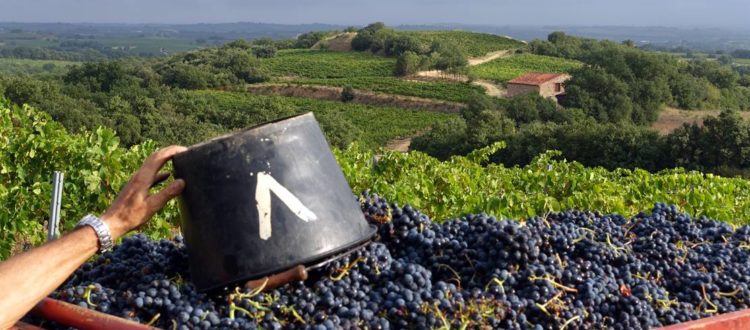Roussillon: 2018 – A Qualitative Vintage
The perfect conditions were met to foster a 2018 qualitative vintage: a dry winter, followed by a wet spring counterbalanced by the winds of the Tramontane, and a summer punctuated by heat waves, yet tempered by ongoing water intakes.
A positive outcome for the Roussillon vineyard and its producers who have therefore welcomed the return to normal production volumes, after the historically low volumes of the 2016 and 2017 vintages.
An intense but balanced climate
Following a dry winter, the Roussillon vineyard has been well-watered by rain during the spring season, with 262 mm/m2, a 42% increase from the documented average. The rainfalls allow the replenishment of the water reserves in the soil and provided the hydric conditions conducive of the healthy growth of the vineyard during the vegetative cycle.
Spring rainfalls have also forced the winemaker to a rigorous diligence commanding the tracking of the state of the sanitary condition in the vineyard, in order to contain phytosanitary pressure. Fortunately, the Tramontane, a powerful northwest wind originating from the mountain ranges and blowing towards the Golfe du Lion, played an instrumental role in the natural remediation by drying over the soil after each rain episodes. But beyond these natural factors, it is truly the know-how of the winemakers that has, despite this forgiving spring, preserved the sanitary condition of the vineyard.
The replenishment of the water reserves, combined with relatively low temperatures during the spring season, have withstood the intense heat in August, and ensured a relatively normal growing cycle, from budburst to harvest.
Due to the absence of hydric stress, the vegetation thrived and allowed good grapes and leaves balance.
Maturity has developed normally and the harvest of white and rosé grape varieties have succeeded each other at a steady pace from the end of July.
As for the red grape varieties, the cool nights have slowed down the kinetic maturity, delaying harvesting, and putting the nerves of the winemakers to the test.
From early September, the average night and morning temperatures have favored optimal ripening of the phenolic compounds of the grape, while preserving their acidity content, and the freshness of their aromatic profile. Depending on the areas, the harvest of the red grape varieties has started from one to two weeks after the end of the picking of the white grape varieties.
The harvest season for the majority of the dry wines has thus spread over an especially long period, from the end of July to early October, whereas for the fortified sweet wines (“VDN” =Vins Doux Naturels) and the red grape varieties at an altitude above 350m, the wait lasted until Mid-October.
A promising vintage
White and rsé dry wines, as well as the fortified Muscat de Rivesaltes (VDN), have soon developed a delicate aromatic profile, evoking floral and fresh fruit notes.
The first tastings of red after devatting revealed wines that are rich, textured and supported by a refreshing acidity. A profile enhanced by the malolactic fermentation, which provided an additional layer of intense and precise aromas.
The vintage 2018 shows a great potential with an aromatic complexity that is simultaneously youthful and profound, as well as a smooth and elegant texture marked by ripe and velvety tannins. It illustrates perfectly the respect that the winemakers carry on in the vineyard, fully committed to revealing the identity of the diversity of their terroirs.
his highly qualitative vintage is distinctive from the earlier ones in its moderate, yet more representative of the normal, production volumes, after a 2016 vintage historically low in Roussillon, and a 2017 vintage characterized by modest production volume across the Mediterranean coast.
2018 may become one of the greatest vintages expressed by the Roussillon vineyard!
2018全新优质年份
得天独厚的葡萄种植条件为培育2018优质年份葡萄酒奠定了基础:有利于葡萄生长的干燥冬季气候,随后是潮湿的春季气候,从阿尔卑斯山和西地中海向南或西南吹来的Tramontana干冷北风抵消了湿润的水汽,群山阻隔了炎热的夏季浪潮。
在2016和2017年葡萄历史低收成后,这对露喜龙葡萄园和生产者们来说是一个重要积极的结果,因此生产者们欣喜的欢迎葡萄收割回归正常产量。
极端但平衡的气候条件
干燥的冬季过后,春季的露喜龙葡萄园雨水充足,灌溉面积达到262毫米/平方米,较有记录以来的平均值增长了42%。降雨可以填补土壤中的水分储备,并在营养周期过程中提供有利于葡萄园健康生长的水分条件。
春雨还迫使酿酒师对葡萄园进行更加严密的指挥观察,跟踪葡萄园的卫生状况,以抑制植物遭受雨水病害的压力。幸运的是,来自山区的强劲Tramontane干冷西北风吹向里昂湾(The Golfe du Lion),在每次雨期后使土壤变得干燥,对自然修复起了重要作用。但是在这个春意盎然的季节里,除了这些自然因素之外,得益于酿酒师们的专业技能,保护了葡萄园的卫生条件。
水资源储备的补给,加上春季相对较低的温度,植物经得住8月的高温酷暑,并确保了从发芽到收割的生长周期相对正常。
而由于没有含氢水分胁迫,植被生长旺盛,使葡萄和叶子保持良好平衡生长。
从七月底开始,酿造白葡萄酒和桃红葡萄酒的葡萄品种成熟度正常发展,他们以稳定的步伐互相接替,产量稳步增长。
对于红葡萄酒品种来说,凉爽的夜晚减缓了葡萄的动力学成熟度,因此收获时间延长,也考验了酿酒师的神经。
9月初起,早晚平均温度有利于葡萄酚类化合物的最佳成熟,同时保持了葡萄的酸度和芳香新鲜度。根据地区的不同,红葡萄酒品种在白葡萄酒品种采摘结束后1 – 2周开始收获。
从7月底到10月初,大部分酿造于干型葡萄酒的葡萄进入了漫长的采摘季,而在海拔350米以上的高度采摘酿造于加强型天然甜和红葡萄酒的葡萄品种,收割一直持续到10月中旬。
潜质十足的年份
干白、干桃红葡萄酒,和加强型里维萨特麝香天然甜,很快便有了它们专属的微妙香气标签——焕发迷人花香和新鲜水果的气息。
首次品尝红葡萄酒后,便能感到葡萄酒丰富的饱满度,结构感,环绕口腔的清爽酸度。这些香气由于苹果乳酸的发酵加强了酒体的风味,为酒体增添了一层浓郁而精准的香气。
葡萄酒既年轻又深刻的香气层次,使2018全新年份表现出巨大的潜力。同时,单宁成熟而醇和,口感柔滑而优雅,显示了酿酒师参与葡萄园工作时对大自然的尊重,更完美的展现出土壤多样性的特征。
这些高品质年份与之前的不同,更能代表正常产量下的优质年份。2016年露喜龙葡萄产量处于历史低点后,2017年份以地中海沿岸为主要的葡萄酒产量适中。
2018,将成为露喜龙葡萄园最伟大的年份之一!

